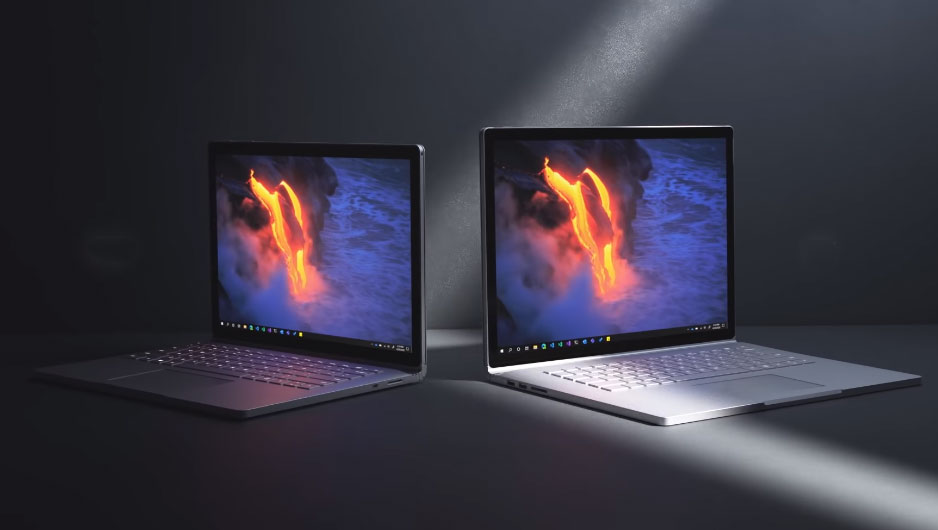Microsoft's Surface Book is now a respectable gaming laptop
The Surface Book 3 is still productivity-first, but optional Nvidia Turing GPUs give it some gaming clout—at high prices.

Productivity and gaming laptops are distinct categories, but sometimes the lines get blurred. That's the case with Microsoft's new Surface Pro 3 laptops. Microsoft accurately bills the Surface Pro 3 as its "most powerful laptop ever," and while it still comes dressed in productivity attire, it has some optional gaming chops—though at a higher price than many laptops that are purpose-built for gaming.
The Surface Book 2 that these new configurations replace also had some gaming options, but this time around, discrete GPU options are based on Nvidia's latest generation Turing architecture. Buyers with the requisite funds can optionally make the leap from integrated graphics to a GeForce GTX 1650 Max-Q GPU with 4GB of GDDR5 memory on the 13.5-inch model, while the 15-inch model comes standard with a GeForce GTX 1660 Ti Max-Q GPU with 6GB of GDDR6.
Max-Q variants mean you ultimately give up some performance to keep things cooler, which makes it possible to jam higher end GPUs into a thin and light form factor. However, both discrete GPUs are far and way better suited for gaming than integrated graphics.
To that end, Microsoft says "people who love to game" will find that the 15-inch model packs "enough power to play the top Xbox Game Pass for PC titles at 1080p in a smooth 60 frames per second." In other words, Microsoft has gamers in its sights. Developers as well, who can opt for a model with a Quadro RTX 3000.
While the Surface Book 2 also shipped with a discrete GPU option (based on Pascal), the Surface Book 3 promises to be better suited for gaming, and not just in raw power. The Verge notes the Surface Book 2 it tested last year had trouble holding a full charge when plugged in and gaming because the AC adapter was under powered. For the Surface Book 3, Microsoft's Robert Seiler told the site the charger's been upgraded from 102W to 127W to address that very issue.
"When you max out the power you will not get it plugged in and not charging," Seiler explained. "We’ve tested for it, it was one of the key things we wanted to address this time around."
On the CPU side, the Surface Book 3 gets a bump to Intel's 10th generation Ice Lake processors (10nm). There are two CPU options, both with 4 cores and 8 threads: a Core i5 1035G7 (1.2GHz to 3.7GHz, 6MB L3 cache) and a Core i7 1065G7 (1.3GHz to 3.9GHz, 8MB L3 cache).
Keep up to date with the most important stories and the best deals, as picked by the PC Gamer team.
Buyers can also outfit the Surface Book 3 with up to 32GB of RAM, twice as much as before, and what Microsoft claims is "the fastest SSD we have ever shipped." Microsoft didn't provide any performance figures, but we do know it's using NVMe drives that shuttle data over the PCIe bus. Capacities max out at 1TB in the 13.5-inch model, and 2TB in the 15-inch model.
The caveat to all this is pricing. Here's the breakdown:
- 13.5-inch w/ Core i5, 8GB RAM, 256GB SSD—$1,599.99
- 13.5-inch w/ Core i7, 16GB RAM, 256GB SSD, GTX 1650 Max-Q—$1,999.99
- 13.5-inch w/ Core i7, 32GB RAM, 512GB SSD, GTX 1650 Max-Q—$2,499.99
- 13.5-inch w/ Core i7, 32GB RAM, 1TB SSD, GTX 1650 Max-Q—$2,699.99
- 15-inch w/ Core i7, 16GB RAM, 256GB SSD, GTX 1660 Ti Max-Q—$2,299.99
- 15-inch w/ Core i7, 32GB RAM, 512GB SSD, GTX 1660 Ti Max-Q—$2,799.99
- 15-inch w/ Core i7, 32GB RAM, 1TB SSD, GTX 1660 Ti Max-Q—$2,999.99
- 15-inch w/ Core i7, 32GB RAM, 2TB SSD, GTX 1660 Ti Max-Q—$3,399.99
You're looking at two grand to wade into discrete GPU waters, and a few hundred dollars more if you want the bigger model with the faster 1660 Ti.
Part of the premium pricing goes to the display. These are touchscreen panels with a 3000x2000 resolution on the 13.5-inch model, and 3240x2160 resolution on the 15-inch model, each with a high 1600:1 contrast ratio.
Other amenities include Wi-Fi 6 (802.11ax) connectivity, a 5MP front-facing camera and 8MP rear-facing camera, two USB 3.1 Gen2 Type-A ports, a single USB 3.1 Gen2 Type-C port (with power delivery), a 3.5mm headphone jack, full-size SDXC card reader, and two proprietary Surface Connect ports.
These are slick laptops, and with Turing GPU options now available, the gaming angle is legit. It's also a pricey proposition, if gaming is your primary (or only) goal.
We're starting to see some compelling gaming laptops based on AMD's Ryzen 4000 mobile series, like the Asus TUF Gaming A15 with a GeForce RTX 2060 GPU for $1,300. And as we highlight in our roundup of cheap gaming laptop deals, MSI's GF63 Thin with a GeForce GTX 1650 can be had for $699. And at the high end, a $3000 MSI GE66 Raider will include an RTX 2080 Super Max-Q, whereas for the same price you get a GTX 1660 Ti Max-Q in a Surface Book.
The Surface Book 3 will release on May 21.
Paul has been playing PC games and raking his knuckles on computer hardware since the Commodore 64. He does not have any tattoos, but thinks it would be cool to get one that reads LOAD"*",8,1. In his off time, he rides motorcycles and wrestles alligators (only one of those is true).


